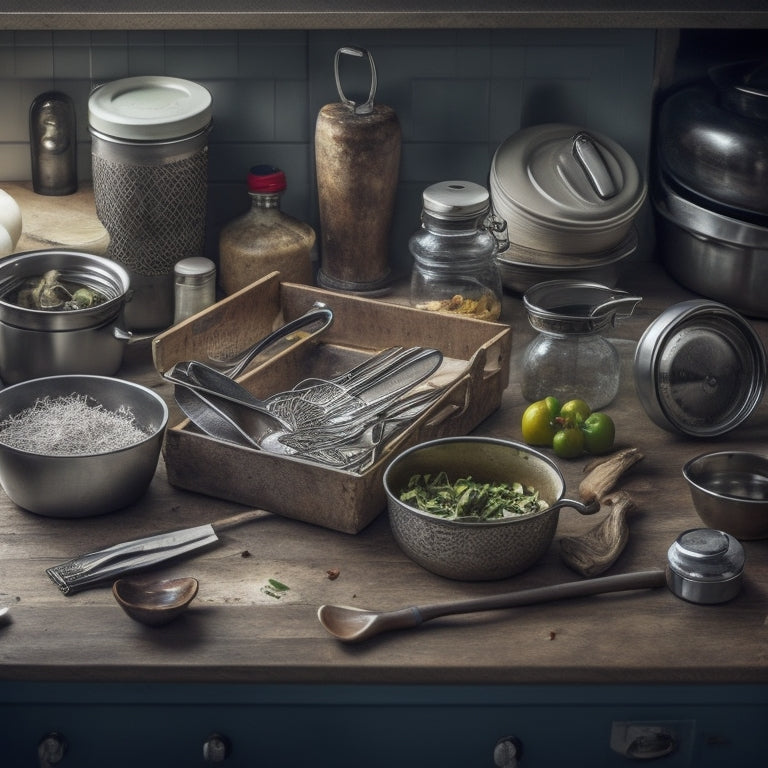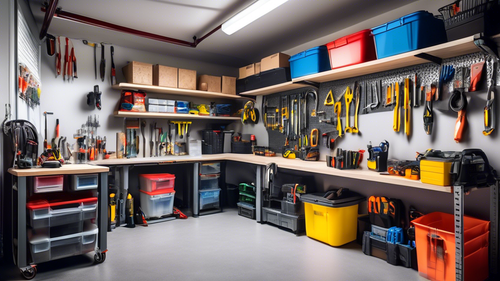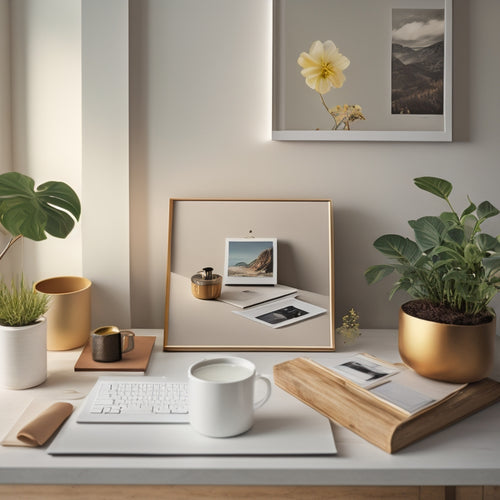
What's Holding You Back From Organized Kitchen Drawers?
Share
You're likely struggling with disorganized kitchen drawers because you're caught between the desire for a system that works and the fear of committing to one that doesn't. Maybe you're worried about making irreversible mistakes or feeling overwhelmed by the numerous product options online. Perhaps you're unsure about how to customize your drawer organization to fit your unique needs or are limited by your drawer's size and shape. Whatever the reason, it's holding you back from achieving the organized kitchen drawers you've always wanted. But by identifying the root cause of your hesitation, you'll be one step closer to creating a system that streamlines your meal prep and cleanup.
Key Takeaways
• Fear of irreversible mistakes and ineffective solutions holds people back from organizing their kitchen drawers.
• Limited knowledge of maximizing drawer space and efficiency due to unique shape and size constraints.
• Uncertainty about choosing the right products and materials for customized organization solutions.
• Lack of creativity in DIY organization solutions and repurposing items at home.
• Inability to establish and maintain a cleaning routine and organizational system, leading to clutter buildup.
Assessing Your Current Drawer Situation
Take stock of your current kitchen drawer setup by pulling everything out and examining the contents, layout, and overall condition of each drawer. This is the first step towards achieving effective drawer organization. You'll likely be surprised at the clutter and disarray that's accumulated over time.
As you sort through each item, ask yourself: 'Do I really need this?' Be honest – if it's broken, outdated, or redundant, consider letting it go. This decluttering process is essential in creating a functional and efficient kitchen space.
Next, assess the physical condition of your drawers. Are they worn, scratched, or stuck? Identify any areas that need repair or replacement. Take note of the drawer's dimensions, including the width, height, and depth. This will help you determine the best storage solutions for your kitchen essentials.
Fear of Committing to a System
As you consider organizing your kitchen drawers, you may be hesitant to commit to a system because you're afraid of making a mistake that's hard to reverse.
You might be worried that you'll invest time and resources into a solution that doesn't ultimately work for you.
These fears are rooted in concerns about permanence, unclear goals, and uncertainty about success - let's explore these obstacles and how to overcome them.
Fear of Permanence
You may hesitate to organize your kitchen drawers because you're worried that the system you choose will be inflexible and impossible to change if your needs evolve. You're not alone in this fear of permanence. Many people put off organizing their kitchen drawers because they're afraid of committing to a system that mightn't work out in the long run.
The good news is that you don't have to choose between flexibility and organization. Temporary solutions like removable dividers or stackable containers can help you test out different layouts without making a long-term commitment. Adjustable organizers can be tweaked as your needs change, ensuring your system remains effective.
Don't be afraid to try out different configurations through trial and error. Flexible storage options like baskets or bins can be easily rearranged or replaced as your needs evolve.
Lack of Clear Goals
Having conquered the fear of permanence, you're now faced with defining what organization means to you and what you want to achieve in your kitchen drawers.
This is where many people get stuck, as they're unsure of what they want to accomplish or how to get there. Without clear goals, you'll struggle to create a system that works for you.
To overcome this hurdle, ask yourself:
-
What're your top priorities for your kitchen drawers? Is it reducing clutter, increasing storage, or improving functionality?
-
How much time are you willing to dedicate to maintaining your organized system each week?
-
What boundaries do you need to set to guarantee everyone in the household is on board with the new system?
- What specific benefits do you hope to achieve from having organized kitchen drawers, such as reduced stress or increased productivity?
Uncertainty of Success
Fear of committing to a system holds many people back from achieving organized kitchen drawers, mainly because they doubt their ability to sustain the new order and worry that their efforts will ultimately be in vain. You're not alone if you've fallen victim to this mindset. Perfectionist tendencies can lead to procrastination, causing you to delay starting the organizing process altogether.
You might think, 'If I can't do it perfectly, why bother?' But this mindset only perpetuates clutter and disorganization. Self-doubt and a negative mindset can also paralyze you from taking action. You may think, 'I've tried organizing before, and it didn't stick, so why try again?' or 'I'm just not organized, it's not in my nature.' These thoughts are detrimental to your progress and hold you back from achieving your goals.
Recognizing these patterns and reframing your thinking is crucial. Instead of focusing on perfection, aim for progress. Remind yourself that undertaking small steps and making adjustments as you go is acceptable. By overcoming your uncertainty of success, you'll be one step closer to achieving the organized kitchen drawers you've always wanted.
Lack of Customization Options
One major drawback of many kitchen drawer organizers is that they often come with fixed, one-size-fits-all designs that don't accommodate your unique storage needs. This lack of customization options can be frustrating, especially when you're trying to maximize your kitchen's storage potential. You deserve a system that's tailored to your specific requirements, not a generic solution that forces you to adapt to its limitations.
The benefits of customization are clear:
-
Personalized solutions: With customized drawer organizers, you can create a system that's designed specifically for your kitchen's layout, your cooking style, and your storage needs.
-
Increased efficiency: Customized organizers help you make the most of your available space, reducing clutter and making it easier to find what you need when you need it.
-
Improved organization: By tailoring your organizer to your specific needs, you can create a system that's intuitive and easy to use, making meal prep and cleanup a breeze.
- Enhanced productivity: With a customized organizer, you'll spend less time searching for misplaced items and more time focusing on what matters – cooking and enjoying your meals.
Drawer Size and Shape Limitations
You're likely familiar with the frustration of trying to fit a pre-made organizer into a kitchen drawer that's an irregular shape or size, only to find it doesn't quite fit or leaves wasted space. This is a common problem, especially in older homes or custom-built kitchens where standard sizes don't apply.
The result is a drawer layout that's inefficient and cluttered, making it hard to find what you need when you need it.
Drawer size and shape limitations are a major obstacle to achieving organized kitchen drawers. Space constraints can make it difficult to accommodate bulky items, like pots and pans, or long utensils, like spatulas and whisks. This leads to a cluttered and disorganized drawer that's more frustrating than functional.
To overcome this challenge, you need to think creatively about how to maximize the space you have. Consider customizing your drawer layout to fit your specific needs, or using adjustable dividers to make the most of the space you have.
Inadequate Storage for Utensils
Utensils like spatulas, whisks, and tongs often get jumbled together in a kitchen drawer, making it difficult to find what you need quickly. This cluttered mess can lead to frustration and wasted time in the kitchen. To overcome this, you need to rethink your utensil storage.
Here are some creative solutions to get you started:
-
Divide and Conquer: Use drawer dividers or inserts to separate utensils by type or frequency of use. This keeps similar items together and prevents clutter from building up.
-
Utilize Vertical Space: Install a pegboard or a utensil organizer on the back of a cabinet door to maximize storage and keep frequently used items within easy reach.
-
Choose the Right Container: Select a utensil holder or tray that fits your drawer size and shape, ensuring that everything has a designated spot.
- Purge and Refine: Get rid of duplicate or broken utensils, and consider storing less frequently used items in a separate drawer or cabinet.
Limited Budget for Organizers
Since you're working with a limited budget for organizers, you'll need to get creative to maximize your kitchen drawer's storage potential.
You can start by making your own DIY drawer dividers using materials you already have at home.
DIY Drawer Dividers
With a little creativity, you can create functional DIY drawer dividers that keep your kitchen utensils organized without breaking the bank. You don't need to spend a fortune on custom drawer inserts or adjustable organizers to achieve the organized kitchen of your dreams. Instead, get creative with materials you already have at home.
Here are some ideas to get you started:
-
Use cardboard boxes or paper towel rolls to create makeshift dividers that separate your utensils into categories.
-
Repurpose old folders or file organizers to create customized compartments for your kitchen tools.
-
Utilize adhesive-backed Velcro to attach small baskets or containers to the sides of your drawers, creating extra storage space.
- Transform old picture frames into custom drawer dividers by attaching them to the drawer walls with screws or adhesive.
Repurpose Old Containers
By raiding your pantry, closet, or recycling bin, you can uncover a treasure trove of old containers that can be repurposed as makeshift drawer dividers. This container makeover is a cost-effective way to organize your kitchen drawers without breaking the bank.
You can use old plastic containers, cardboard boxes, or even mason jars to create separate compartments for your utensils, spices, or cookware.
Think outside the box and get creative with your upcycling hacks. For instance, use an old tin can to store paper clips or rubber bands, or transform a cardboard tube into a holder for your kitchen knives.
With a little imagination, you can turn trash into functional storage innovations.
Difficulty in Measuring Drawers Correctly
Measure inaccurately, and you'll end up with a kitchen drawer organizer that's a poor fit, wasting valuable space and causing frustration. Measuring challenges can be a significant barrier to achieving your dream kitchen drawers. You might think it's simple, but it's easy to get it wrong.
When measuring your drawers, you'll face space limitations that can make it challenging to get precise readings. To overcome these challenges, keep the following tips in mind:
-
Take multiple measurements: Don't rely on a single measurement. Take several readings to verify accuracy.
-
Consider the drawer's depth: Don't forget to measure the depth of your drawer, as this can impact the size of your organizer.
-
Measure around obstructions: If you have obstacles like drawer dividers or hinges, make sure to measure around them.
- Use a level: Verify your measurements are straight and even to avoid any mistakes.
Overwhelming Product Options Online
You're faced with a dizzying array of kitchen drawer organizer products online, making it tough to pinpoint the perfect solution for your unique needs. With so many options, it's easy to get lost in the sea of products, each claiming to be the best. To cut through the noise, focus on product quality and customer reviews.
Look for organizers made from durable materials that can withstand the wear and tear of daily use. Check out customer reviews to get a sense of how well a product performs in real-life situations.
Another essential factor to ponder is the brand reputation and return policy. A reputable brand will stand behind its product, offering a hassle-free return or exchange if you're not satisfied. Be wary of brands with poor customer service or unclear return policies.
Uncertainty About Maintenance Needs
Even with a high-quality kitchen drawer organizer in place, uncertainty about maintenance needs can hinder your ability to keep your drawers organized and clutter-free over time. You might be thinking, 'How often should I clean my drawer organizer?' or 'What's the best way to prevent clutter from building up again?' These questions can leave you feeling unsure and unmotivated to maintain your newly organized space.
To overcome this uncertainty, it's crucial to establish a routine and follow some simple maintenance tips. Here are a few to get you started:
-
Set a reminder to clean your drawer organizer every 3-6 months to prevent dust and dirt from accumulating.
-
Implement the 'one in, one out' rule to maintain a balanced amount of kitchen utensils and gadgets.
-
Designate a specific day each week to tidy up your kitchen drawers and keep them organized.
- Consider implementing a 'home' for each item in your kitchen, making it easier to find what you need and preventing clutter from building up.
Frequently Asked Questions
How Do I Declutter My Drawers Without Wasting My Favorite Items?
"When decluttering, you're torn between sentimental items and minimalism. Don't worry, you can keep your favorite items while achieving organization. Identify storage solutions that honor sentimental value, and you'll declutter without guilt or regret."
Can I Still Organize My Drawers if I Rent My Home?
You can still organize your kitchen drawers even if you rent, using temporary solutions and creative ideas that don't require permanent changes, like adhesive hooks and removable dividers, to create a rental-friendly organization system that works for you.
Are Customized Drawer Organizers Worth the Extra Cost?
As you stand at the crossroads of decision, a golden key to accessing your kitchen's potential dangles before you. Are customized drawer organizers worth the extra cost? You can opt for DIY drawer dividers or invest in tailored solutions, but consider this: precision fit equals precision power.
How Often Should I Clean and Reorganize My Kitchen Drawers?
You should clean and reorganize your kitchen drawers every 2-3 months to maintain efficiency; regularly clearing clutter and adjusting your layout guarantees top-notch drawer organization and functionality, saving you time and energy.
Can I Organize My Drawers Without Buying Any New Products?
"Imagine a treasure chest overflowing with hidden gems - that's your existing kitchen items waiting to be repurposed. You can create DIY organization systems without breaking the bank; think mason jars, cardboard dividers, and repurposed containers for a sustainable, budget-friendly solution."
Related Posts
-

Garage Organization Tips for Overcrowded Spaces
Decluttering and Maximizing Space If your garage has become an unmanageable clutter zone, it's time to reclaim you...
-

Simplify Your Digital Life: Photo and Video Organization
You're drowning in a sea of digital clutter, with thousands of disorganized photos and videos scattered across your d...
-

3 Kitchen Hacks for a Clutter-Free Home
You can achieve a clutter-free kitchen by implementing three simple hacks: clear off countertops by designating spots...


